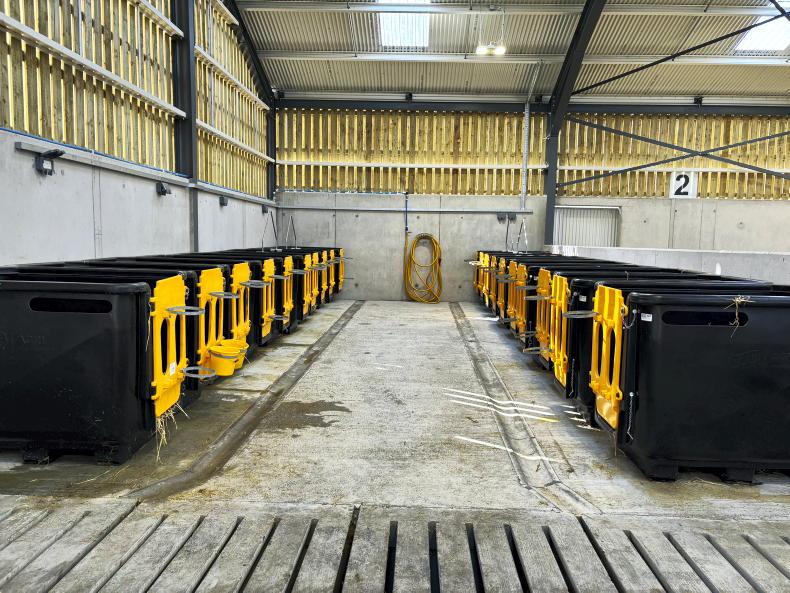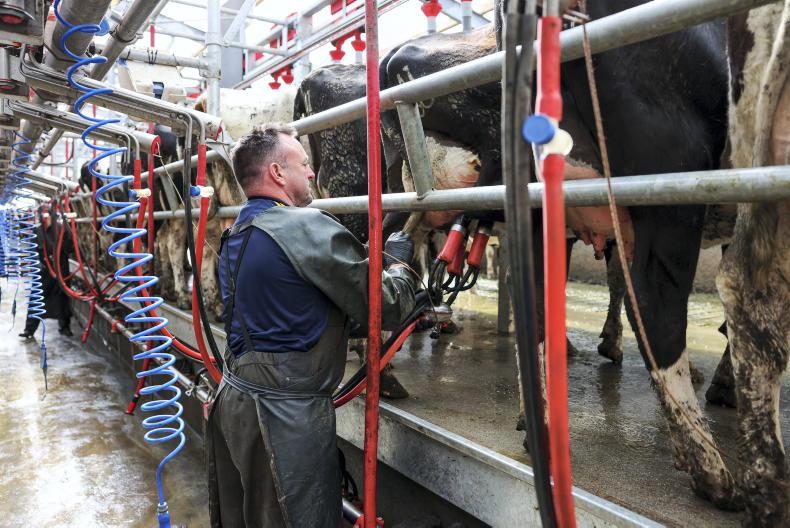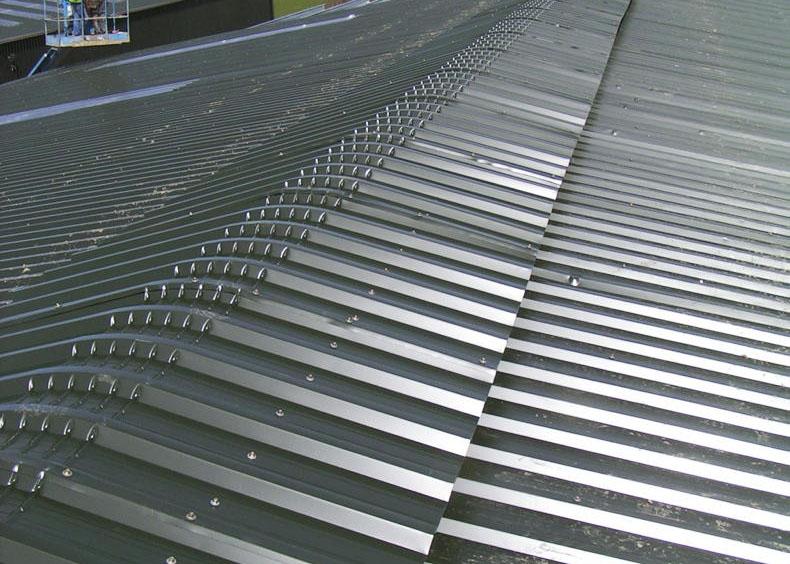VAT and farmers have a complex relationship. The majority of farmers are not VAT-registered for the simple reason that it would be not beneficial to them.
For farmers selling produce, be it milk, beef or grain, a 5% charge on all sales (not profits) is taken by Revenue.
For a typical 90-cow dairy farm supplying 450,000 litres in 2023, this would equate to €166,500 in milk sales alone, with the VAT on this being €8,325. Factor in sales of cull cows and calves, and this figure is probably closer to €10,000.
“Yes, but surely if a farmer is VAT-registered, they can reclaim VAT on expenditure like any other business?” you might ask. Yes, but being VAT-registered as opposed to not being VAT-registered has a lot less benefits for a farm compared to other non-agricultural businesses, due to the Flat-rate VAT scheme.
Flat-rate Scheme
The Flat-rate Scheme is a special scheme for farmers who are not registered, or required to register, for Value-Added Tax (that is, VAT). These farmers are commonly referred to as ‘flat-rate farmers’.
The scheme is designed to compensate flat-rate farmers for the VAT they incur on farming costs without having to register.
If you’re unsure what bracket you fall in to, you are likely a flat-rate farmer.
According to Revenue, flat-rate farmers who are not registered for VAT may reclaim VAT paid by them in relation to the construction, extension, alteration or reconstruction of:
Farm buildings and structures;Land drainage;Land reclamation;Hedgerows;Underpasses.Farmers must submit applications for repayment of VAT within four years from the end of the taxable period to which the claim relates by filling out the VAT 58 form (available on the Revenue website or through some agricultural advisers and accountants).
Quite often, farmers will hold off on making VAT reclaims until they have a decent amount of VAT accrued, using the VAT reclaim to cover a farm investment or a lean financial period, such as the dry period on dairy farms.
What the Flat-rate VAT system doesn’t cover is investments in farm machinery or vehicles; movable items.
Tractors, telehandlers and quads are ineligible, as are slurry tankers, trailers, balers and tilling equipment.
Farmers who elect to register for VAT and charge VAT on the sale of goods or services can claim back VAT on these items.
In this sense, someone who may not sell a large amount of goods and regularly update machinery may find it more lucrative to be VAT-registered.
Revenue’s view
Revenue has maintained their view from the beginning, with them stating: “Revenue has not changed its approach to the refund order. Rather, each claim is assessed on its own merits.”
Although, farmers would argue that they have recently been experiencing difficulties in securing reclaims on items that were previously simple to reclaim from indicates otherwise.
Milking parlours, bulk tanks, slurry scrapers, meal bins and automatic calf feeders were some of the first items that farmers had issues with. Bar the meal bin, the other four items could be classed as ‘machinery/equipment’.
What the Flat-rate VAT system doesn’t cover is investments in farm machinery or vehicles
Revenue’s view on this is that “the equipment must be permanently installed in the farm building or structure and, once installed, cannot be removed without causing significant damage, or destruction to the farm building or structure or to the equipment itself.”
So, why this change from Revenue? Revenue maintains there has been no change, but if a flat-rate farmer could claim VAT back on a meal bin last year and is unable to do so now, then there has been a change, be it in rules or interpretation thereof.
Table 2 shows the VAT reclaims from unregistered farmers over the past 10 years, which was provided by Minister for Finance, Michael McGrath, when questioned by Dublin TD Emer Higgins on the VAT issues.
In 2014, €55m was reclaimed, and as farmers have continued to invest in infrastructure over the past decade, we have now seen this figure rise to €88m, an increase of 60%.
Could it have been the case that the VAT amount being reclaimed by flat-rate farmers was just becoming too much of a loss to the exchequer?
Dairy industry
This has been driven in large by the dairy industry, where we have seen the national herd grow from 1.209 million in 2013 to 1.665 million in 2023, with farm infrastructure having to be constructed to accommodate this 37% rise in dairy cow numbers.
The Dairy Equipment Scheme (DES) under TAMS III, launched by the Department of Agriculture last year, received a major slimming down from its predecessor, TAMS II.
Rotary parlours received the chop, while herringbone parlours were limited to 10-units being eligible for grant aid.
No building work for the construction of milking parlours, including pits, stall work or feeders, is eligible under the new DES. The two together would hint at an effort to cap the further expansion of the dairy herd.
The Department’s view and TAMS
The Department has stated that the issues surrounding VAT are “a Revenue issue”, and they would be right in doing so. However, where the Department would have some scope to soften the changes made by Revenue is through TAMS reference costs.
We previously highlighted in the Irish Farmers Journal that a four-station calf-feeder holds a reference cost of €13,500, while actual costs have been quoted as being €18,500 (plus VAT).
Where the Department would have some scope to soften the changes made by Revenue is through TAMS reference costs
Reference costs have been historically low in TAMS, but the real issue now is that farmers are out of pocket to the tune of €2,000 (based off a 40% grant rate) on the feeder, plus the VAT amount, which is several thousand euros more, as they can no longer reclaim this.
The Department has said that they are currently processing the applications from Tranche 1 of the scheme and will review costings based off what items farmers are buying and the receipt costs of these in the latter stages of the year.
Revenue is to provide further clarity on the issue in the coming weeks. In the short term, farmers who had initially been refused a VAT reclaim on drafting gates, new build parlours or hydraulic slurry scrapers should contact Revenue regarding retrospective payment of the VAT.
With calf exports and labour on dairy farms under pressure, the exclusion of automatic calf-feeders from the eligibility list is disappointing, and the onus now will be on the Department to bring the reference cost more in line with actual costs to stem the loss.
I am constructing a new parlour, which will include the construction of a new building and the installation of a new herringbone
parlour and bulk tank.
What elements of my
investment are eligible
for a VAT reclaim?
In short, all of the above will be eligible. Construction of new buildings has always been eligible under the flat-rate VAT scheme, while new parlours and bulk tanks remain eligible despite recent changes.
I have a digger and driver coming in the next few weeks to clean drains and prepare to erect a new fence. Are there any changes to digger hire or fencing materials regarding VAT?
Farm fencing works remain eligible for a VAT reclaim, as do
any costs associated with drainage or land reclamation. The receipt from the digger work should show that this is the type of work being carried out.
I am reroofing an old hayshed with new timbers and cladding. Can I reclaim the VAT back on these costs?
From our understanding of the rules, no. VAT reclaims for
repair work to existing buildings are not covered under the Flat-rate Scheme.
I am VAT-registered. Can I reclaim VAT on a computerised calf feeder?
Yes, as a VAT-registered farmer, you are eligible to reclaim VAT related to relevant expenditure for your business, which the calf-feeder would fall under.
VAT and farmers have a complex relationship. The majority of farmers are not VAT-registered for the simple reason that it would be not beneficial to them.
For farmers selling produce, be it milk, beef or grain, a 5% charge on all sales (not profits) is taken by Revenue.
For a typical 90-cow dairy farm supplying 450,000 litres in 2023, this would equate to €166,500 in milk sales alone, with the VAT on this being €8,325. Factor in sales of cull cows and calves, and this figure is probably closer to €10,000.
“Yes, but surely if a farmer is VAT-registered, they can reclaim VAT on expenditure like any other business?” you might ask. Yes, but being VAT-registered as opposed to not being VAT-registered has a lot less benefits for a farm compared to other non-agricultural businesses, due to the Flat-rate VAT scheme.
Flat-rate Scheme
The Flat-rate Scheme is a special scheme for farmers who are not registered, or required to register, for Value-Added Tax (that is, VAT). These farmers are commonly referred to as ‘flat-rate farmers’.
The scheme is designed to compensate flat-rate farmers for the VAT they incur on farming costs without having to register.
If you’re unsure what bracket you fall in to, you are likely a flat-rate farmer.
According to Revenue, flat-rate farmers who are not registered for VAT may reclaim VAT paid by them in relation to the construction, extension, alteration or reconstruction of:
Farm buildings and structures;Land drainage;Land reclamation;Hedgerows;Underpasses.Farmers must submit applications for repayment of VAT within four years from the end of the taxable period to which the claim relates by filling out the VAT 58 form (available on the Revenue website or through some agricultural advisers and accountants).
Quite often, farmers will hold off on making VAT reclaims until they have a decent amount of VAT accrued, using the VAT reclaim to cover a farm investment or a lean financial period, such as the dry period on dairy farms.
What the Flat-rate VAT system doesn’t cover is investments in farm machinery or vehicles; movable items.
Tractors, telehandlers and quads are ineligible, as are slurry tankers, trailers, balers and tilling equipment.
Farmers who elect to register for VAT and charge VAT on the sale of goods or services can claim back VAT on these items.
In this sense, someone who may not sell a large amount of goods and regularly update machinery may find it more lucrative to be VAT-registered.
Revenue’s view
Revenue has maintained their view from the beginning, with them stating: “Revenue has not changed its approach to the refund order. Rather, each claim is assessed on its own merits.”
Although, farmers would argue that they have recently been experiencing difficulties in securing reclaims on items that were previously simple to reclaim from indicates otherwise.
Milking parlours, bulk tanks, slurry scrapers, meal bins and automatic calf feeders were some of the first items that farmers had issues with. Bar the meal bin, the other four items could be classed as ‘machinery/equipment’.
What the Flat-rate VAT system doesn’t cover is investments in farm machinery or vehicles
Revenue’s view on this is that “the equipment must be permanently installed in the farm building or structure and, once installed, cannot be removed without causing significant damage, or destruction to the farm building or structure or to the equipment itself.”
So, why this change from Revenue? Revenue maintains there has been no change, but if a flat-rate farmer could claim VAT back on a meal bin last year and is unable to do so now, then there has been a change, be it in rules or interpretation thereof.
Table 2 shows the VAT reclaims from unregistered farmers over the past 10 years, which was provided by Minister for Finance, Michael McGrath, when questioned by Dublin TD Emer Higgins on the VAT issues.
In 2014, €55m was reclaimed, and as farmers have continued to invest in infrastructure over the past decade, we have now seen this figure rise to €88m, an increase of 60%.
Could it have been the case that the VAT amount being reclaimed by flat-rate farmers was just becoming too much of a loss to the exchequer?
Dairy industry
This has been driven in large by the dairy industry, where we have seen the national herd grow from 1.209 million in 2013 to 1.665 million in 2023, with farm infrastructure having to be constructed to accommodate this 37% rise in dairy cow numbers.
The Dairy Equipment Scheme (DES) under TAMS III, launched by the Department of Agriculture last year, received a major slimming down from its predecessor, TAMS II.
Rotary parlours received the chop, while herringbone parlours were limited to 10-units being eligible for grant aid.
No building work for the construction of milking parlours, including pits, stall work or feeders, is eligible under the new DES. The two together would hint at an effort to cap the further expansion of the dairy herd.
The Department’s view and TAMS
The Department has stated that the issues surrounding VAT are “a Revenue issue”, and they would be right in doing so. However, where the Department would have some scope to soften the changes made by Revenue is through TAMS reference costs.
We previously highlighted in the Irish Farmers Journal that a four-station calf-feeder holds a reference cost of €13,500, while actual costs have been quoted as being €18,500 (plus VAT).
Where the Department would have some scope to soften the changes made by Revenue is through TAMS reference costs
Reference costs have been historically low in TAMS, but the real issue now is that farmers are out of pocket to the tune of €2,000 (based off a 40% grant rate) on the feeder, plus the VAT amount, which is several thousand euros more, as they can no longer reclaim this.
The Department has said that they are currently processing the applications from Tranche 1 of the scheme and will review costings based off what items farmers are buying and the receipt costs of these in the latter stages of the year.
Revenue is to provide further clarity on the issue in the coming weeks. In the short term, farmers who had initially been refused a VAT reclaim on drafting gates, new build parlours or hydraulic slurry scrapers should contact Revenue regarding retrospective payment of the VAT.
With calf exports and labour on dairy farms under pressure, the exclusion of automatic calf-feeders from the eligibility list is disappointing, and the onus now will be on the Department to bring the reference cost more in line with actual costs to stem the loss.
I am constructing a new parlour, which will include the construction of a new building and the installation of a new herringbone
parlour and bulk tank.
What elements of my
investment are eligible
for a VAT reclaim?
In short, all of the above will be eligible. Construction of new buildings has always been eligible under the flat-rate VAT scheme, while new parlours and bulk tanks remain eligible despite recent changes.
I have a digger and driver coming in the next few weeks to clean drains and prepare to erect a new fence. Are there any changes to digger hire or fencing materials regarding VAT?
Farm fencing works remain eligible for a VAT reclaim, as do
any costs associated with drainage or land reclamation. The receipt from the digger work should show that this is the type of work being carried out.
I am reroofing an old hayshed with new timbers and cladding. Can I reclaim the VAT back on these costs?
From our understanding of the rules, no. VAT reclaims for
repair work to existing buildings are not covered under the Flat-rate Scheme.
I am VAT-registered. Can I reclaim VAT on a computerised calf feeder?
Yes, as a VAT-registered farmer, you are eligible to reclaim VAT related to relevant expenditure for your business, which the calf-feeder would fall under.










SHARING OPTIONS